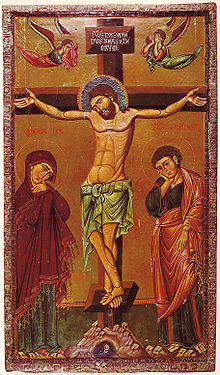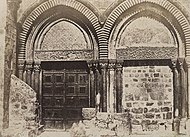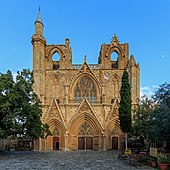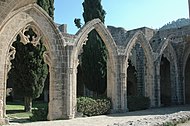Art of the Crusades

Crusader art or the art of the Crusades, meaning primarily the art produced in Middle Eastern areas under
The crusaders encountered a long and rich artistic tradition in the lands they conquered at the end of the 11th century and the beginning of the 12th.

Crusader art in the Levant, like the history of the Crusader kingdoms in general, falls clearly into two, or three, periods. The first begins with the First Crusade which culminated in 1099 with the bloody taking of Jerusalem and the establishment of the Kingdom of Jerusalem and other states to the north. The following decades were turbulent but artistically productive, until the catastrophe of 1187 saw the Crusader defeat at the Battle of Hattin and the fall of Jerusalem to Saladin. In the second period the Kingdom of Jerusalem was now hugely reduced in size to control only a few coastal towns and the areas around them, which were gradually whittled away by the Muslims until the final Siege of Acre (1291) ended Crusader presence in the Levant. However the kingdom still controlled Cyprus, taken from the Byzantine Empire, and the House of Lusignan continued to rule there, and later the Armenian Kingdom of Cilicia, until respectively 1489 and the late 14th century, representing the third period of Crusader art, not counted as such by all sources; in Cyprus the Gothic style is often found.[2]
There is a further sense of "Crusader art" to cover the art produced in the Latin Empire that usurped much of the Byzantine Empire, ruled by the Crusaders between the Sack of Constantinople in 1204 by the Fourth Crusade and 1261. Saint Catherine's Monastery in Sinai was also a centre during this time, and perhaps later. This art had a larger impact in Europe, to which many artists probably returned after the collapse of the regime, influencing Italo-Byzantine painting there. The crusades were also important as a subject in Western art, mainly in illuminated luxury versions of the many histories that were popular reading with Western elites.
Illuminated manuscripts
An example of the mixture of different styles is the
There was also a scriptorium in Acre which produced many well known manuscripts such as
Mosaics, frescoes and panel paintings

An example of the mixture of styles is the
Sculpture

Figurative
Another major pilgrimage basilica, the Church of the Annunciation in Nazareth, was just nearing the completion of a major rebuilding in 1187. Saladin in fact left the Christians in place and does not seem to have damaged the building. However the church was seriously damaged in the next major upheaval in the area, the invasion in 1267 by the Mamluk ruler Baybars, and the sculptures remaining from the church all suffered. In 1908 five extra capitals were excavated, having, it is presumed, been buried in 1187 soon after they were made but before they were put in place, when news of Saladin's approach reached the town. These are in excellent condition, and some of the most famous sculptures of the Crusader period.[7]
The situation is rather different with decorative sculpture, where local influence is much stronger. The beautifully carved and complex decoration on the arches and cornices over the doors into the Church of the Holy Sepulchre is unlike anything in France from this period and reflects local development of Syrian late Roman styles; some parts are probably re-used Roman material. The neighbouring capitals, "based on
The end of Crusader art
After the rapid collapse of the
In Cyprus, the Lusignan kingdom continued to produce work, including the Gothic cathedrals of
Gallery
-
Latin Empire damaged icon, from a Greek church. The central figure of St George is in painted relief, and clearly Latin in style and clothing
-
Several levels of architectural decoration over the doors of the Church of the Holy Sepulchre
-
The Holy Sepulchre lintels, still in place in 1856.
-
Holy Sepulchre entrance capitals
-
The main front of the Lala Mustafa Pasha Mosque, once Saint Nicholas' Cathedral, Famagusta, Cyprus (note minaret added top left)
-
Gothic arches of Bellapais Abbey in Cyprus
-
Kolossi Castle near Limassol, Cyprus
Influences on Europe
There was also crusade-related art produced back in Europe, from the many illuminated crusade chronicles such as the Old French translation of William of Tyre, to architecture such as the round churches built by the Knights Templar in the style of the Holy Sepulchre, and the Sainte-Chapelle in Paris built to accommodate relics brought back from the East. Luxurious printed textiles began to be produced in Europe at around the end of the Crusades, and may well have been another influence. In general, it is often not possible to say with certainty whether influences or new types of objects arriving in Europe at this period did so via Islamic Spain, the Byzantine world, or the Crusader states. Historians tend to discount the importance of the Crusader States in this regard, despite the very well developed Italian trading networks there. European castle-building was certainly decisively influenced by the crusaders.
See also
Notes
References
- ISBN 9780521835831)
Further reading
- Evans, Helen C. & Wixom, William D., The glory of Byzantium: art and culture of the Middle Byzantine era, A.D. 843-1261, pp. 389, 1997, The Metropolitan Museum of Art, New York, ISBN 9780810965072; full text available online from The Metropolitan Museum of Art Libraries
- Folda, Jaroslav. Crusader Art in the Twelfth Century, B.A.R., 1982.
- ISBN 9780853319955)
- Kühnel, Bianca. Crusader Art of the Twelfth Century: A Geographical, an Historical, or an Art Historical Notion?, Berlin: Gebr. Mann, 1994.
- Weiss, Daniel H. Art and Crusade in the Age of Saint Louis, Cambridge University Press, 1998. (ISBN 9780521621304)






